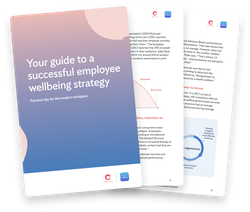
4 reasons for employee absenteeism (and how to fix them)

Written by
Writer, Culture Amp
Employee absenteeism is a challenge for all businesses. When people don’t come to work, it impacts productivity and service delivery. If left unchecked, it can delay projects, undermine customer satisfaction, and eat into the bottom line.
Of course, you can expect a certain amount of legitimate absence. Illness, injury, and unforeseen circumstances are a natural part of life. But certain incidences of employee absenteeism – especially repeated absences – may be a symptom of deeper issues.
In this article, we explore what absenteeism is and highlight the four deeper issues that can lead to employee absenteeism. We discuss each of them in turn and address how to manage them.
What is absenteeism?
Employee absenteeism (sometimes described as workplace absenteeism) is when an employee habitually misses or skips out on work without a valid reason. Generally, these absences are unplanned and have cascading effects on the rest of the workplace. While a few unplanned absences aren't a big deal, a pattern of absenteeism is a cause for concern.
4 common reasons for employee absenteeism
What drives absenteeism? There are various reasons, but in our experience working with over 6,000 companies, we find that the four most common causes are as follows:
1. An employee is sick due to their work (aka, burnout)
There is a fine line between good stress and bad stress. Good stress is motivating and exhilarating, whereas bad stress is overwhelming and stymying.
Even if an employee is fully engaged in their work, they can burn out if they are repeatedly put under too much stress (or the wrong type of stress). Burnout is a long-term stress reaction that can present as physical and/or mental collapse. Employees can feel overwhelmed, hopeless, and exhausted.
“A key aspect of the burnout syndrome is increased feelings of emotional exhaustion; as emotional resources are depleted, workers feel they are no longer able to give of themselves on a psychological level,” states The Maslach Burnout Inventory Manual.
Burnout is clearly not good for the employee, but neither is it good for the employer. Multiple academic studies have shown the correlation between burnout and absenteeism, intention to leave, turnover, and decreased job performance.
It may be tempting to dismiss burnout as the reason for your employees' absenteeism. However, stress-induced absenteeism is perhaps more widespread than you think:
- Approximately 40% of absent days are due to mental health problems such as stress.
- 35% of working Americans reported experiencing chronic work stress, and less than half said their employer provides sufficient resources to help employees manage their stress
- Between 2010–11 and 2014–15, around 91% of workers’ compensation claims involving a mental health condition were linked to work-related stress or mental stress
What you can do about it
Well-being is a holistic understanding of someone’s physical, emotional, mental, and social state. It’s more than wellness, which typically focuses on a person’s physical health. When people are in a state of wellbeing at work, they can develop their potential, work productively and creatively, build positive relationships with others, cope with the everyday stresses of life, and make a meaningful contribution.
If your employees are burning out and you don’t already have an employee well-being program, it’s time to start researching them – if you have a wellness program, it’s time to scrutinize it honestly.).
A successful employee well-being strategy is proactive, holistic for the individual and company, respects employee privacy, and is integrated into the company's cultural norms. We recommend focusing on aspects largely impacted or determined by workplace factors to affect employee wellbeing. This means that, as a company, you can directly address any of the areas rather than provide support.
2. An employee is absent because they don’t want to be at work (aka, disengaged)
This one shouldn’t be too surprising. If someone isn’t engaged at work, they often try to spend less time there. This adds up to higher levels of absenteeism.
Alternatively, engaged employees are "less likely to be sick." Those who see their job as worthwhile or exciting are more likely to be fully involved in and enthusiastic about what they do.
You may be nodding along at this point. This is relatively straightforward stuff that most of us have experienced during our working life. However, less straightforward is how we fix this. How do you encourage an employee to be more engaged?
First, you need to understand why an employee isn’t engaged. Perhaps they dislike working with their manager, or they don’t have the tools they need to succeed. Maybe they feel like they don’t belong, or maybe they feel like there is no potential growth path for them. The reasons are seemingly endless. However, until you understand the specifics regarding your employee, your ability to address the issue is severely limited.
What you can do about it
Honestly, this can be a tricky issue to deal with. It requires a sincere one-to-one conversation, which may be difficult if you don’t have a solid relationship with your employee. That's why teaching your managers the right way to give employee feedback is important.
However, remember that this conversation isn’t just about giving feedback. It’s about finding the root cause of your employee’s absence and working with them to fix it. There is no wrong answer they can give you. It’s simply how they feel.
Once you’ve discovered the reason for their absenteeism, it’s time to put some new processes in place. For example, brainstorm what could make their role more interesting if they're bored at work. Again, work together to mutually find solutions that address the issue at the source.
After you’ve got everything set up, ensure you have a way to measure your success. Goal-setting is one way that managers and their team members can transparently align on goals and track progress.
Tip: If you think there are engagement issues throughout your team or company, you must figure out what's driving disengagement at your company and take meaningful steps to improve employee engagement. Employee engagement surveys are a great way to collect data that reveals high-impact areas of opportunities.
3. An employee is at work in person but not in mind (aka, presenteeism)
Presenteeism is “being present at work but limited in some aspects of job performance by a health problem.” Most people have seen this once or twice in their careers. This makes sense when you consider the data, which finds that about $224 billion is taken out of the US economy annually due to lost productivity from absence and presenteeism.
In fact, according to data from the Virgin Pulse Science Advisory Board, presenteeism is just as costly to a business's bottom line as absenteeism. Their data shows that, on average, employees took about four sick days each year. However, when the numbers on how many days they lost on the job came in, the number climbed to 57.5 days per year per employee.
As Virgin Pulse says, “That’s almost 12 working weeks – or one quarter of the entire year – that businesses are paying for employees who are present in the body, but not in mind.”
What you can do about it
You can tackle presenteeism like absenteeism: discover the reason for the lack of engagement, take steps to address the issue, and measure the impact of the changes you’ve made.
4. An employee is experiencing personal issues
It’s important to remember that your employee has a life outside of work. They have a whole world you may never see and private issues you know nothing about – embrace their humanity at work. However, that doesn’t mean you can’t support them.
What you can do about it
If you discover that your employee has personal issues or stressors causing them to miss work, try to accommodate these. Juggling work and private life can be a logistical nightmare. Employers can often reduce employees’ stress by simply offering more flexibility.
Talk to your employees and find out what would help, for example: working from home, flexible work hours, or a higher number of unpaid vacation days. Honestly, this is just an extension of any good well-being program.
Of course, you and your company culture must support these decisions. It’s no good to offer flexible hours if your employee receives scornful looks from the early birds when they come in at 10 am. A well-being program should be holistic and fully integrated into the company culture and values.
Take action on workplace absenteeism
We hope this article has helped illuminate employee absenteeism and how you can address it. There is always a reason why an employee doesn’t come to work, whether it’s boredom, anxiety, burnout, or any other myriad of reasons. It’s up to managers and leaders to unearth why these employees are experiencing absenteeism and then take the appropriate steps to support their employees and resolve the heart of the issue.


